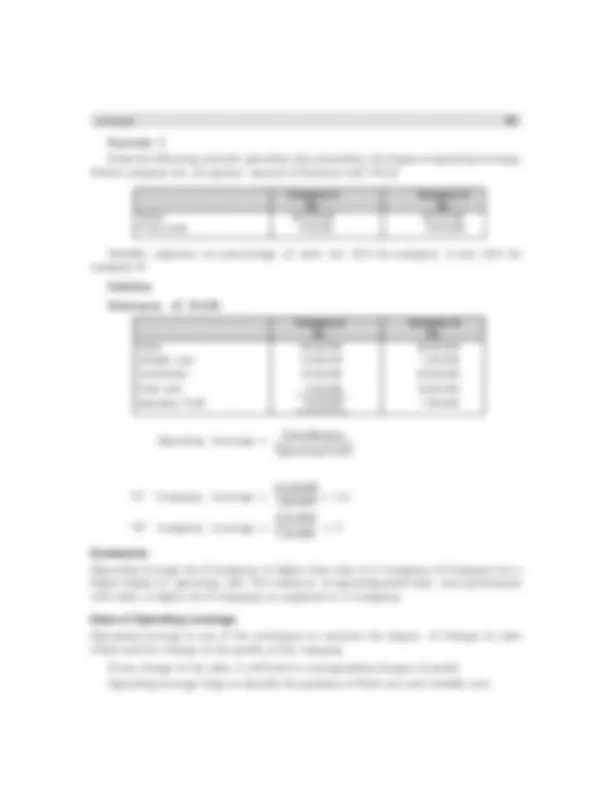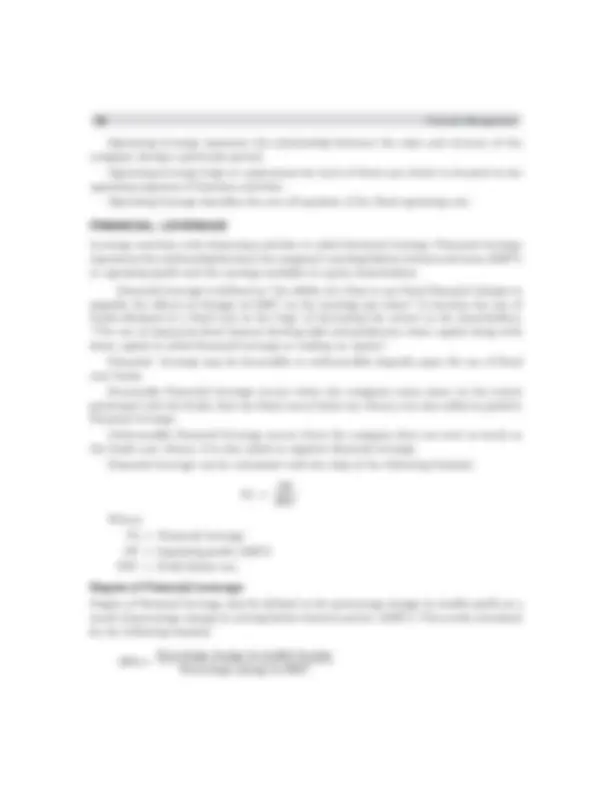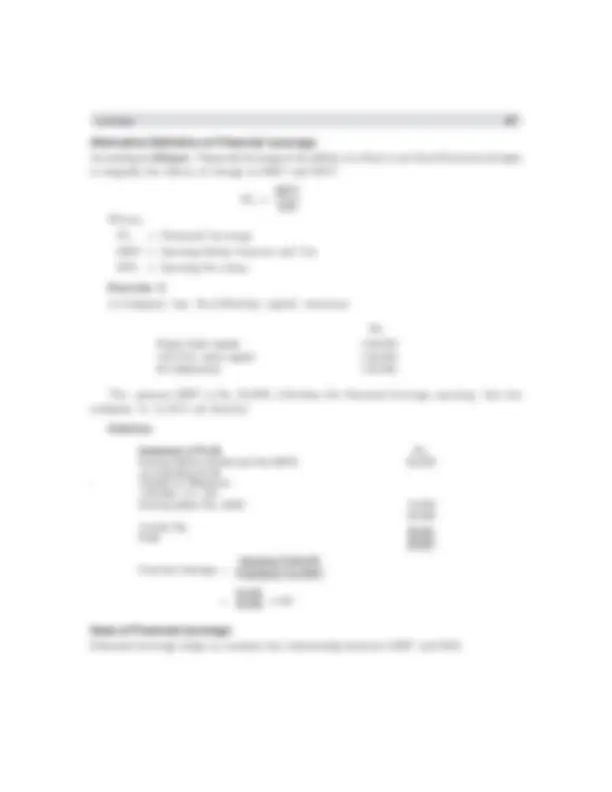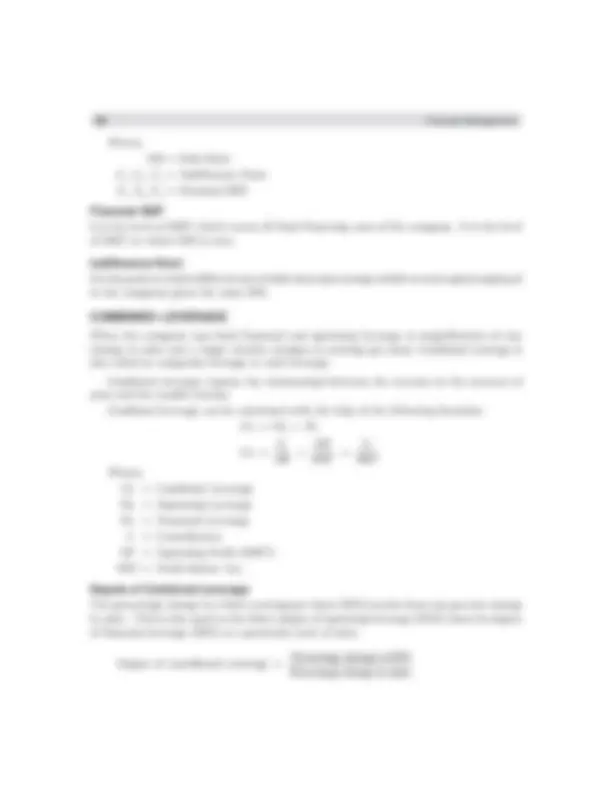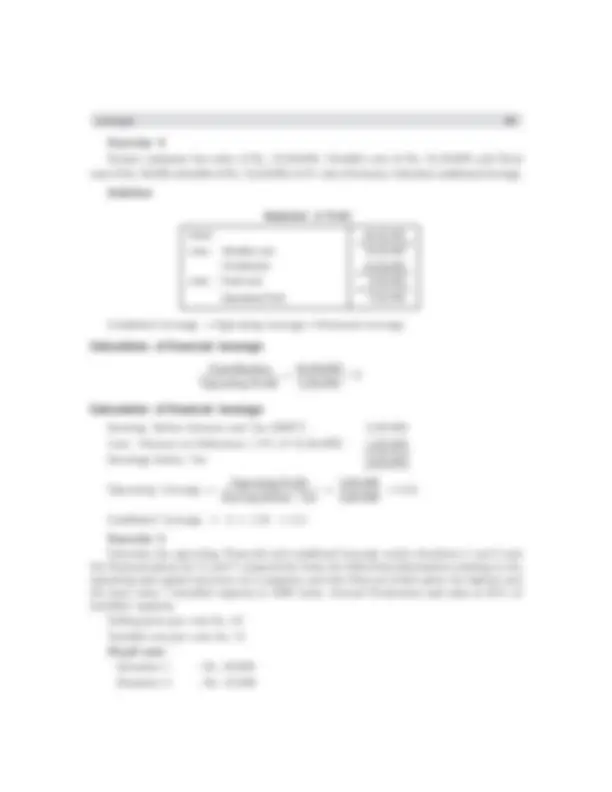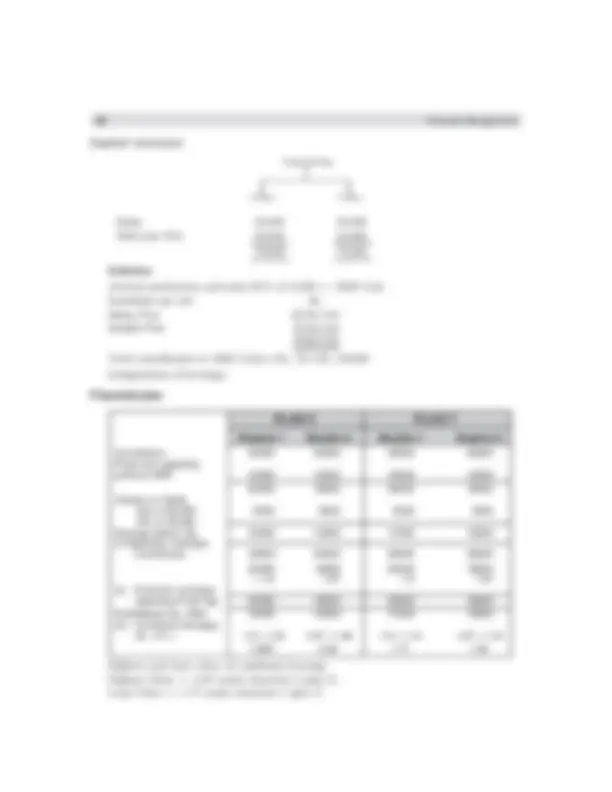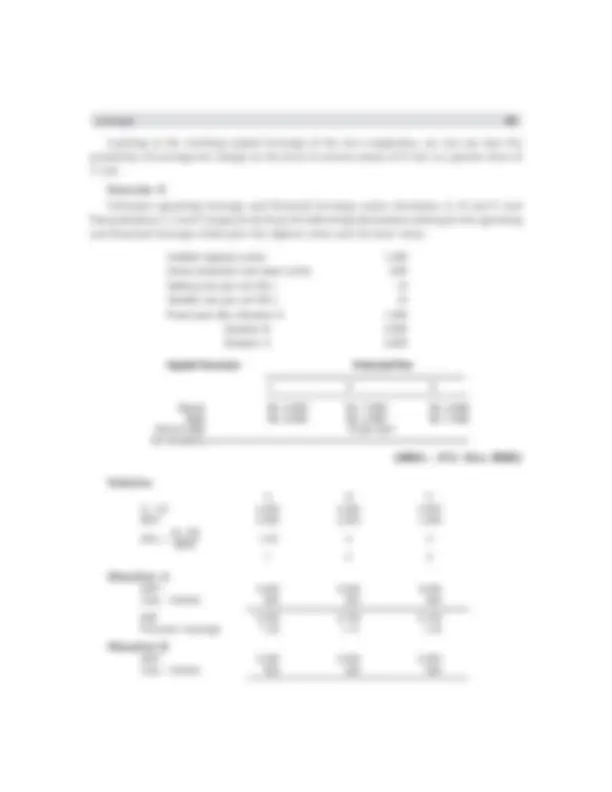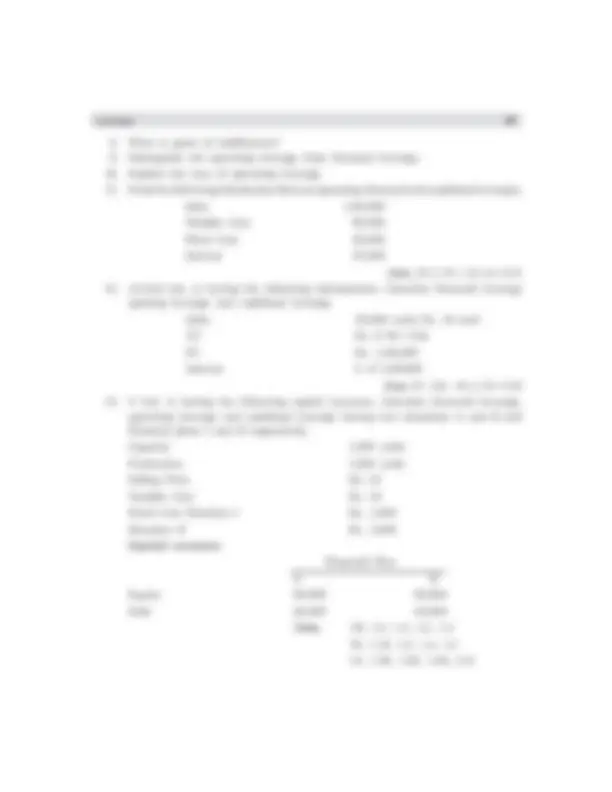Download Leverage; Financial Management and more Study notes Finance in PDF only on Docsity!
INTRODUCTION
Financial decision is one of the integral and important parts of financial management in
any kind of business concern. A sound financial decision must consider the board coverage
of the financial mix (Capital Structure), total amount of capital (capitalization) and cost of
capital (Ko ). Capital structure is one of the significant things for the management, since it
influences the debt equity mix of the business concern, which affects the shareholder’s
return and risk. Hence, deciding the debt-equity mix plays a major role in the part of the
value of the company and market value of the shares. The debt equity mix of the company
can be examined with the help of leverage.
The concept of leverage is discussed in this part. Types and effects of leverage is discussed
in the part of EBIT and EPS.
Meaning of Leverage
The term leverage refers to an increased means of accomplishing some purpose. Leverage
is used to lifting heavy objects, which may not be otherwise possible. In the financial point
of view, leverage refers to furnish the ability to use fixed cost assets or funds to increase
the return to its shareholders.
Definition of Leverage
James Horne has defined leverage as, “the employment of an asset or fund for which the
firm pays a fixed cost or fixed return.
Types of Leverage
Leverage can be classified into three major headings according to the nature of the finance
mix of the company.
84 Financial Management
Leverage
Finacial Leverage
Operating Leverage
Composite Leverage
Fig. 7.1 Types of Leverage
The company may use finance or leverage or operating leverage, to increase the EBIT
and EPS.
OPERATING LEVERAGE
The leverage associated with investment activities is called as operating leverage. It is caused
due to fixed operating expenses in the company. Operating leverage may be defined as the
company’s ability to use fixed operating costs to magnify the effects of changes in sales on
its earnings before interest and taxes. Operating leverage consists of two important costs
viz., fixed cost and variable cost. When the company is said to have a high degree of
operating leverage if it employs a great amount of fixed cost and smaller amount of variable
cost. Thus, the degree of operating leverage depends upon the amount of various cost
structure. Operating leverage can be determined with the help of a break even analysis.
Operating leverage can be calculated with the help of the following formula:
OL =
C
OP
Where,
OL = Operating Leverage
C = Contribution
OP = Operating Profits
Degree of Operating Leverage
The degree of operating leverage may be defined as percentage change in the profits resulting
from a percentage change in the sales. It can be calculated with the help of the following
formula:
DOL =
Percentage change in profits
Percentage change in sales
86 Financial Management
Operating leverage measures the relationship between the sales and revenue of the
company during a particular period.
Operating leverage helps to understand the level of fixed cost which is invested in the
operating expenses of business activities.
Operating leverage describes the over all position of the fixed operating cost.
FINANCIAL LEVERAGE
Leverage activities with financing activities is called financial leverage. Financial leverage
represents the relationship between the company’s earnings before interest and taxes (EBIT)
or operating profit and the earning available to equity shareholders.
Financial leverage is defined as “the ability of a firm to use fixed financial charges to
magnify the effects of changes in EBIT on the earnings per share”. It involves the use of
funds obtained at a fixed cost in the hope of increasing the return to the shareholders.
“The use of long-term fixed interest bearing debt and preference share capital along with
share capital is called financial leverage or trading on equity”.
Financial leverage may be favourable or unfavourable depends upon the use of fixed
cost funds.
Favourable financial leverage occurs when the company earns more on the assets
purchased with the funds, then the fixed cost of their use. Hence, it is also called as positive
financial leverage.
Unfavourable financial leverage occurs when the company does not earn as much as
the funds cost. Hence, it is also called as negative financial leverage.
Financial leverage can be calculated with the help of the following formula:
FL =
OP
PBT
Where,
FL = Financial leverage
OP = Operating profit (EBIT)
PBT = Profit before tax.
Degree of Financial Leverage
Degree of financial leverage may be defined as the percentage change in taxable profit as a
result of percentage change in earning before interest and tax (EBIT). This can be calculated
by the following formula
Percentage change in taxable Income
DFL=
Precentage change in EBIT
Leverage 87
Alternative Definition of Financial Leverage
According to Gitmar , “financial leverage is the ability of a firm to use fixed financial changes
to magnify the effects of change in EBIT and EPS”.
FL =
EBIT
EPS
Where,
FL = Financial Leverage
EBIT = Earning Before Interest and Tax
EPS = Earning Per share.
Exercise 2
A Company has the following capital structure.
Rs. Equity share capital 1,00, 10% Prof. share capital 1,00, 8% Debentures 1,25,
The present EBIT is Rs. 50,000. Calculate the financial leverage assuring that the
company is in 50% tax bracket.
Solution
Statement of Profit Rs. Earning Before Interest and Tax (EBIT) 50, (or) Operating Profit
. Interest on Debenture 1,25,000 × 8 × 100 Earning before Tax (EBT) 10, 40, Income Tax (^) 20, 20,
Financial leverage =
Operating Profit (OP) Profit BeforeTax(PBT)
Uses of Financial Leverage
Financial leverage helps to examine the relationship between EBIT and EPS.
Profit
Leverage 89
Earning before tax (EBT) 8,500 11, Less : Tax at 50% 4,250 5, Earnings available to equity shareholders 4,250 5, No. of equity shares 1,000 4, Earning per share 4.25 1.
DISTINGUISH BETWEEN OPERATING LEVERAGE AND FINANCIAL LEVERAGE
Operating Leverage/Financial Leverage Operating Leverage Financial Leverage
- Operating leverage is associated with 1. Financial leverage is associated with financing investment activities of the company. activities of the company.
- Operating leverage consists of fixed 2. Financial leverage consists of operating profit operating expenses of the company. of the company.
- It represents the ability to use fixed 3. It represents the relationship between EBIT operating cost. and EPS.
- Operating leverage can be calculated by 4. Financial leverage can be calculated by
OL =
C
OP
. FL =
OP
PBT
- A percentage change in the profits resulting 5. A percentage change in taxable profit is the from a percentage change in the sales is result of percentage change in EBIT. called as degree of operating leverage.
- Trading on equity is not possible while the 6. Trading on equity is possible only when the company is operating leverage. company uses financial leverage.
- Operating leverage depends upon fixed 7. Financial leverage depends upon the cost and variable cost. operating profits.
- Tax rate and interest rate will not affect the 8. Financial leverage will change due to tax rate operating leverage. and interest rate.
EBIT - EPS Break even chart for three different financing alternatives
EPS
DR = 70%
X (^1) X 2
X 3
EBIT C 1 C 2 C 3
DR = 0%
DR = 30%
Fig. 7.2 EBIT - EPS Break Even Chart
90 Financial Management
Where,
DR= Debt Ratio
C 1 , C 2 , C 3 = Indifference Point
X 1 , X 2 , X 3 = Financial BEP
Financial BEP
It is the level of EBIT which covers all fixed financing costs of the company. It is the level
of EBIT at which EPS is zero.
Indifference Point
It is the point at which different sets of debt ratios (percentage of debt to total capital employed
in the company) gives the same EPS.
COMBINED LEVERAGE
When the company uses both financial and operating leverage to magnification of any
change in sales into a larger relative changes in earning per share. Combined leverage is
also called as composite leverage or total leverage.
Combined leverage express the relationship between the revenue in the account of
sales and the taxable income.
Combined leverage can be calculated with the help of the following formulas:
CL = OL × FL
CL =
C
OP
×
OP
PBT
C
PBT
Where,
CL = Combined Leverage
OL = Operating Leverage
FL = Financial Leverage
C = Contribution
OP = Operating Profit (EBIT)
PBT = Profit Before Tax
Degree of Combined Leverage
The percentage change in a firm’s earning per share (EPS) results from one percent change
in sales. This is also equal to the firm’s degree of operating leverage (DOL) times its degree
of financial leverage (DFL) at a particular level of sales.
Degree of contributed coverage =
Percentage change in EPS
Percentage change in sales
92 Financial Management
Capital structure:
Financial Plan
X (Rs.) Y (Rs.)
Equity 25,000 50, Debt (cost 10%) 50,000 25, 75,000 75,
Solution
Annual production and sales 60% of 5,000 = 3000 Unit
Contribution per Unit Rs. Selling Price 25 Per Unit Variable Price 15 Per Unit 10 Per Unit
Total contribution is 3000 Units×Rs. 10=Rs. 30,
Computation of leverage.
Financial plan
PLAN-X PLAN-Y
Situation 1 Situation 2 Situation 1 Situation 2 Contribution 30000 30000 30000 30000 Fixed cost operating profit (or) EBIT 10000 12000 10000 12000 20000 18000 20000 18000 Interest on Debts 10% of 50,000 5000 5000 2500 2500 10% of 25, Earnings before Tax 15000 13000 17500 15500 (i) Operating Leverage Contribution 30000 30000 30000 30000 20000 18000 20000 18000 = 1.5 1.67 1.5 1. (ii) Financial Leverage Operating Profit (op) 20000 18000 20000 18000 Profit Before Tax (PBI) 15000 13000 17500 15500 (iii) Combined leverage OL × FL = 1.5 × 1.33 1.67 × 1.38 1.5 × 1.14 1.67 × 1. 1.995 2.30 1.71 1.
Highest and least value of combined leverage.
Highest Value = 2.30 under situation 2 plan X.
Least Value = 1.71 under situation 1 plan Y.
Leverage 93
Exercise 6
Calculate operating, financial and combined leverages under situations when fixed costs are:
(i) Rs. 5,000 and
(ii) Rs. 10,000 and financial plans 1 and 2 respectively from the following information
pertaining to the operating and capital structure of a textile company :
Rs. Total Assets 30, Total Assets turnover 2 Variable cost as percentage of sales 60
Capital structure Financial Plan 1 2
Rs. Rs. Equity 30,000 10, 10% debentures 10,000 30,
Solution
Computation of Leverage Financial Plan
Plan 1 2 Situation i ii i ii Sales 60,000 60,000 60,000 60, Less : Variable cost 36,000 36,000 36,000 36, Contribution 24,000 24,000 24,000 24, Less : Fixed cost 5,000 10,000 5,000 10, Operating profit (EBIT) 19,000 14,000 19,000 14, Less : Interest 1,000 1,000 3,000 3, Profit before tax (PBT) 18,000 13,000 16,000 11, Operating leverage 24,000 24,000 24,000 24, Contribution 19,000 14,000 19,000 14, EBIT 1.26 1.71 1.26 1. Financial leverage 19,000 14,000 19,000 14, EBIT 18,000 13,000 16,000 11, PBT 1.05 1.07 1.18 1. Combined leverage 1.32 1.83 1.49 2.
WORKING CAPITAL LEVERAGE
One of the new models of leverage is working capital leverage which is used to locate the
investment in working capital or current assets in the company.
Working capital leverage measures the sensitivity of return in investment of charges in
the level of current assets.
Leverage 95
Looking at the working capital leverage of the two companies, we can say that the
sensitivity of earnings for charge on the level of current assets of X Ltd. is a greater than of
Y Ltd.
Exercise 8
Calculate operating leverage and financial leverage under situations A, B and C and
financial plans 1, 2 and 3 respectively from the following information relating to the operating
and financial leverage which give the highest value and the least value.
Installed capacity (units) 1, Actual production and sales (units) 800 Selling price per unit (Rs.) 15 Variable cost per unit (Rs.) 10 Fixed costs (Rs.) Situation A 1, Situation B 2, Situation C 3,
Capital Structure Financial Plan
1 2 3
Equity Rs. 5,000 Rs. 7,500 Rs. 2, Debt Rs. 5,000 Rs. 2,500 Rs. 7, Cost of debt 12 per cent (for all plans)
(MBA – P.U. Nov. 2005)
Solution
A B C
S – VC 4,000 4,000 4,
EBIT 3,000 2,000 1,
DOL =
S −VC
EBIT
Situation A
EBIT 3,000 3,000 3,
Less : Interest 600 300 900
EBT 2,400 2,700 2, Financial Leverage 1.25 1.11 1.
Situation B
EBIT 2,000 2,000 2,
Less : Interest 600 300 900
96 Financial Management
EBT 1,400 1,700 1,
Financial Leverage 1.43 1.18 1.
Situation C
EBIT 1,000 1,000 1,
Less : Interest 600 300 900
EBT–I 400 700 100 Financial Leverage 2.5 1.43 10
Exercise 9
‘ XYZ’ company has a choice of the following three financial plans. You are required to
calculate the financial leverage in each case.
Plan I Plan II Plan III Equity capital Rs. 2,000 Rs. 1,000 Rs. 3, Debt Rs. 2,000 Rs. 3,000 Rs. 1, EBIT Rs. 400 Rs. 400 Rs. 400
Interest @10% per annum on debts in all cases.
Solution
Plan I Plan II Plan III Rs. Rs. Rs. EBIT 400 400 400 Less Interest-(I) 200 300 100 EBIT–I 200 100 300 FL 2 4 1.
MODEL QUESTIONS
1. Write a note on trading on equity.
2. What is meant by working capital leverage?
3. What is leverage? Mention different types of leverage?
4. Explain the operating leverage.
5. Discuss the concept of financial leverage.
6. How compared leverage is calculated?
7. Explain the working capital leverage.
98 Financial Management
14. The following details are available for the two companies.
X Ltd. Y Ltd.
Fixed Assets 4,00,000 6,00,
Current Assets 6,00,000 4,00,
Total Asset 10,00,000 10,00,
Earnings Before Interest and Taxes 1,50,000 1,50,
You are required to compare the sensibility of the two companies for a 30%
changes in the level of current assets with the help of using capital leverages.
( Ans. X .73, Y 4.5)

